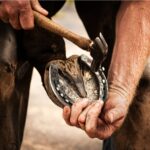National Farriers Week is observed on the second week of July every year and is a chance for horse owners, riders, trainers, and admirers to appreciate and celebrate these experts who ensure that every horse hoof is cared for — the farriers. If you have never heard the term before, worry not, you’ll leave here with more knowledge than you came in with. A farrier is basically a person who practices the art of shoeing horses. The word farrier itself comes from the French ‘ferrier,’ which means ‘blacksmith.’ This, in turn, is a word derived from the Latin ‘ferrum,’ which means iron (hence the symbol ‘Fe’ for iron in the periodic table) and was apt for a blacksmith, who mainly worked with iron. Farriers of old would make horseshoes, and also shoe the horses. Therefore no one would know the workings of the horse’s legs better than the farrier, and no better person to ensure that the horse receives the best care. This alone is worthy of appreciation, so saddle up and get ready to pay homage to these experts for all they do.
History of National Farriers Week
If you’re a member of the equine community or just someone who wants to appreciate those who contribute greatly to the welfare of horses, National Farriers Week is the perfect time to honor the farriers who keep horses in tip-top condition. Celebrated in the second week of July each year, it was first founded in 1998 by the “American Farriers Journal”, to bring to light the growing dearth of farriers in the equine community. Ferriers are those who work with all equine species, which include horses, donkeys, and mules. Though farriers are almost akin to veterinarians, they are not counted as such, because their contribution lies more in the equine industry specifically, often working at racetracks and stables. Essentially the job of a farrier is to keep horses’ hooves healthy and increase their longevity of the movement.
Historically, the profession and art of farriery can be traced back to Ancient Rome, when horses wore horseshoes made out of leather or rawhide straps, referred to by the Romans as ‘hipposandals.’ Before the Norman Conquest of Britain in 1066, there is evidence to suggest the native Britons at the time also shod their horses, and by the 1300s, horseshoes became a common commodity all over medieval Europe. There is a story that William the Conqueror’s farrier was given his own coat of arms and the surname, ‘de Ferrer’, which could be a reference to St. Hilaire de Ferrers, an ironmaking district in France, which is also a reason for the meaning behind the term farrier. Farriers of old had to be experts in both making horseshoes and shoeing the horses, and they were looked upon as general animal doctors too. It wasn’t until 1887, in England, that the Worshipful Company of Farriers set exams to test tradespeople on their knowledge, expertise, and ability to shoe horses and care for their health. Since then, the job of a farrier can only be obtained after a rigorous apprenticeship period, which is reason enough for us to appreciate all that farriers do.
National Farriers Week timeline
The earliest forms of horseshoes are traced back to Roman times.
An official Company of Farriers is established in London, though it is not known why.
The American Association of Professional Farriers (AAPF) is founded, dedicated to continuing the education of farriers.
The “American Farriers Journal” founds National Farriers Week to highlight the need for farriers in the equine industry.
National Farriers Week FAQs
Does shoeing a horse hurt them?
No, horse hooves are made out of keratin (the same stuff our hair and nails are made of) and are incredibly tough. Even though horseshoes are nailed to the hoof of a horse, it is a completely painless process, since the hooves do not contain any nerve endings at all.
Why did they start shoeing horses?
In the same way that shoes protect our feet from harm, horses’ feet needed protection from the carriages during warfare, as well as from the wear and tear that rough terrain would cause them.
When was shoeing horses invented?
The earliest forms of horseshoes can be found as early as 400 B.C. Materials used ranged from plants, rawhide, and leather strap gears referred to as ‘hipposandals’ by the Romans. In Ancient Asia, horsemen equipped their horses with shoes made out of woven plants.
National Farriers Week Activities
Send a tribute
Social media platforms like Instagram, Facebook, Twitter, etc. are great spaces for tribute messages or videos expressing appreciation for farriers all over the world. It’s also a great way to make visible the role of the farrier and the need for more in the equine industries.
Visit a farrier
Find out if there is any equine community near you and visit the local farrier. Spend a day with them to learn more about what they do and what it takes for them to be a farrier in this day and age.
Go horse riding
This way, you can not only enjoy a bit of equine fun, but you can also put yourself in the shoes of a horse (pun intended) and experience what it’s like to care for one of these incredible animals. If horse riding is not the kind of thrill you seek, you can enjoy watching from the sidelines too.
5 Things You May Not Have Heard About Horseshoes
Horseshoes are considered lucky
People used to glue horseshoes over their doorways in the belief that it would bring them luck.
A horseshoe always has seven holes
Since ancient times, the number seven has held significance, hence horseshoes must also always have seven nail holes.
Aluminum horseshoes improve performance
Horseshoes made of aluminum are proven to help horses run faster.
Dreamcatchers step aside, horseshoes work too
Horseshoes are hung above the bed to ward off nightmares, in some cultures.
Farriers were considered magical
It was believed that blacksmiths held magical powers, so to be married by one was good luck.
Why National Farriers Week is Important
It highlights farriers
When was the last time you heard a child aspire to be a farrier? Never? That may be because the art of farriery is not getting the attention it deserves, and farriers are going unappreciated as a result. This is why National Farriers Week aims to highlight the noble art of farriery, honoring those who work hard to ensure the health of horses, so owners can enjoy them longer too.
It’s a week of appreciation
Who doesn’t like being noticed and appreciated for their hard work National Farriers Week makes sure that the hard work of being a farrier does not go unnoticed by the rest of the world, and we’re sure that horses express that appreciation to their farriers too.
It educates the rest of us
For those who may not have anything to do with horses or the equine industry, it gives us a peek into a whole new world, thereby expanding our own knowledge of different careers and ways people contribute.




